engine MITSUBISHI SHOGUN 2008 (in English) Owners Manual
[x] Cancel search | Manufacturer: MITSUBISHI, Model Year: 2008, Model line: SHOGUN, Model: MITSUBISHI SHOGUN 2008Pages: 538, PDF Size: 25.09 MB
Page 433 of 538
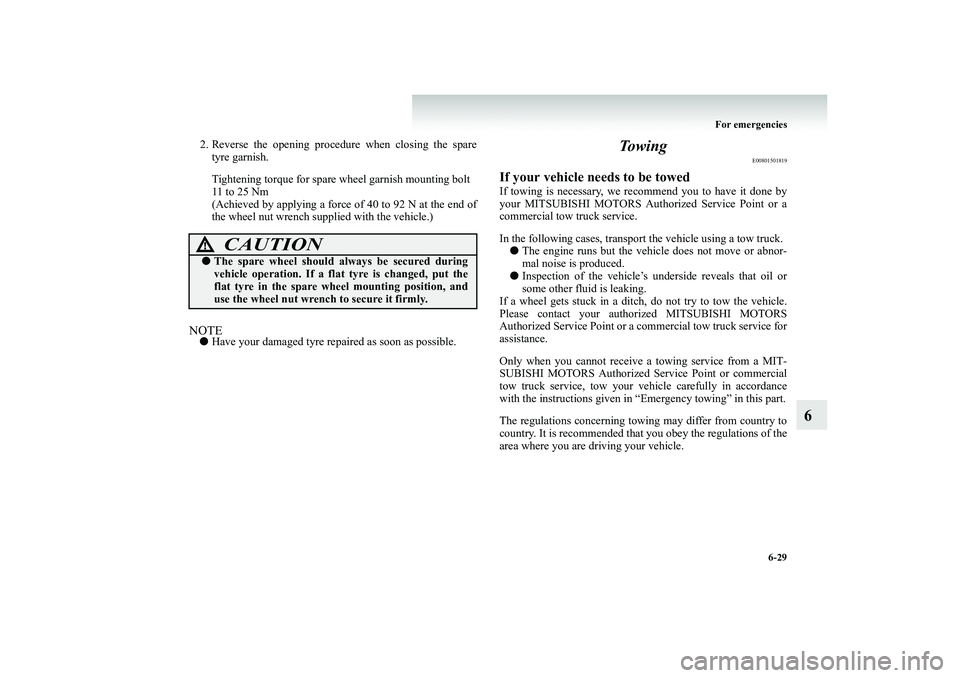
For emergencies
6-29
6
2. Reverse the opening proced
ure when closing the spare
tyre garnish. Tightening torque for spare wheel garnish mounting bolt 11 to 25 Nm (Achieved by applying a force of 40 to 92 N at the end ofthe wheel nut wrench supp
lied with the vehicle.)
NOTE●
Have your damaged tyre repaired as soon as possible.
To w i n g
E00801501819
If your vehicle needs to be towedIf towing is necessary, we recommend you to have it done by your MITSUBISHI MOTORS Authorized Service Point or a commercial tow truck service. In the following cases, transpor
t the vehicle using a tow truck.
●
The engine runs but the vehicle does not move or abnor- mal noise is produced.
●
Inspection of the vehicle’s underside reveals that oil or some other fluid is leaking.
If a wheel gets stuck in a ditch, do not try to tow the vehicle. Please contact your author
ized MITSUBISHI MOTORS
Authorized Service Point or a commercial tow truck service for assistance. Only when you cannot receive
a towing service from a MIT-
SUBISHI MOTORS Authorized Service Point or commercial tow truck service, tow your ve
hicle carefully in accordance
with the instructions given in “Emergency towing” in this part. The regulations concerning towing may differ from country to country. It is recommended that
you obey the regulations of the
area where you are dr
iving your vehicle.
CAUTION
!●
The spare wheel should al
ways be secured during
vehicle operation. If a flat tyre is changed, put the flat tyre in the spare wh
eel mounting position, and
use the wheel nut wrench to secure it firmly.
BK-BK2008E1ENUK.en-uk-Section9.fm Page
29 Wednesday, January 9, 2008 4:46 PM
Page 437 of 538
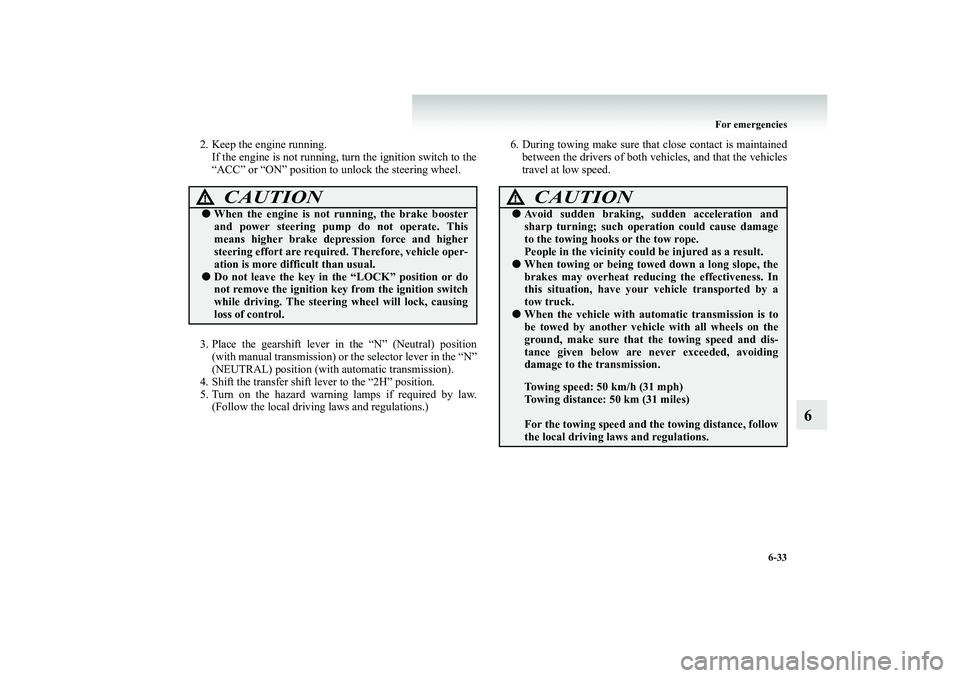
For emergencies
6-33
6
2. Keep the engine running.
If the engine is not running, turn the ignition switch to the “ACC” or “ON” position to unlock the steering wheel.
3. Place the gearshift lever in
the “N” (Neutral) position
(with manual transmission) or the selector lever in the “N” (NEUTRAL) position (with automatic transmission).
4. Shift the transfer shift lever to the “2H” position. 5. Turn on the hazard warning
lamps if required by law.
(Follow the local driving laws and regulations.)
6. During towing make sure th
at close contact is maintained
between the drivers of both ve
hicles, and that the vehicles
travel at low speed.
CAUTION
!●
When the engine is not r
unning, the brake booster
and power steering pump do not operate. This means higher brake depression force and highersteering effort are required.
Therefore, vehicle oper-
ation is more difficult than usual.
●
Do not leave the key in the “LOCK” position or do not remove the ignition ke
y from the ignition switch
while driving. The steering
wheel will lock, causing
loss of control.
CAUTION
!●
Avoid sudden braking,
sudden acceleration and
sharp turning; such opera
tion could cause damage
to the towing hooks or the tow rope.People in the vicinity coul
d be injured as a result.
●
When towing or being towed down a long slope, the brakes may overheat reduci
ng the effectiveness. In
this situation, have your
vehicle transported by a
tow truck.
●
When the vehicle with auto
matic transmission is to
be towed by another vehicl
e with all wheels on the
ground, make sure that the towing speed and dis- tance given below are never exceeded, avoidingdamage to the transmission. Towing speed: 50 km/h (31 mph) Towing distance: 50 km (31 miles) For the towing speed and th
e towing distance, follow
the local driving laws and regulations.
BK-BK2008E1ENUK.en-uk-Section9.fm Page
33 Wednesday, January 9, 2008 4:46 PM
Page 445 of 538
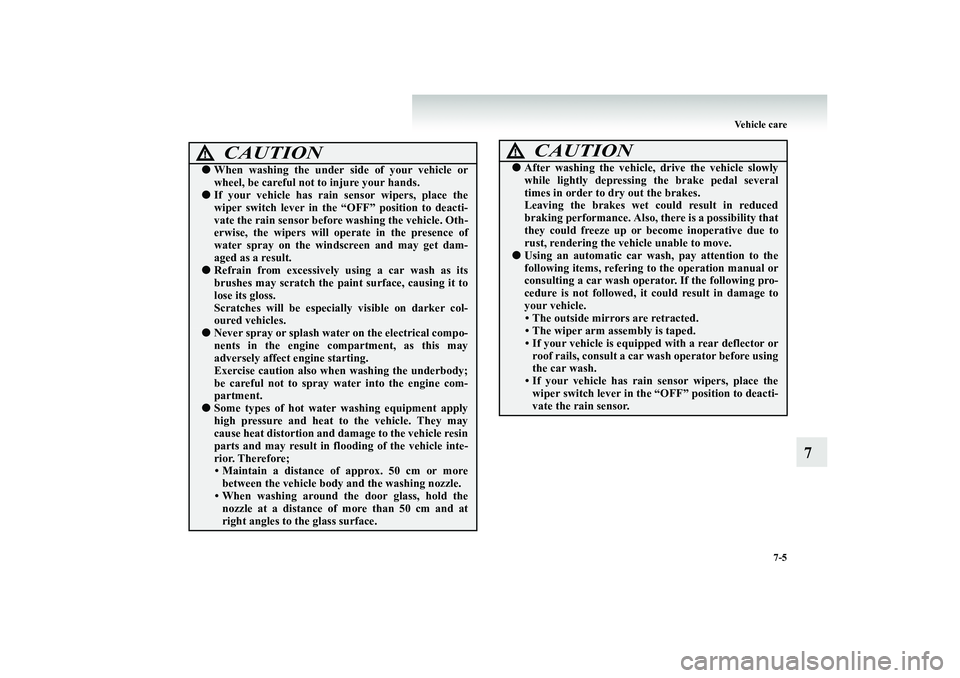
Vehicle care
7-5
7
CAUTION
!●
When washing the under si
de of your vehicle or
wheel, be careful not to injure your hands.
●
If your vehicle has rain sensor wipers, place the wiper switch lever in the
“OFF” position to deacti-
vate the rain sensor before
washing the
vehicle. Oth-
erwise, the wipers will
operate in the presence of
water spray on the windscreen and may get dam- aged as a result.
●
Refrain from excessively using a car wash as its brushes may scratch the pain
t surface, causing it to
lose its gloss. Scratches will be especially
visible on darker col-
oured vehicles.
●
Never spray or splash water on the electrical compo- nents in the engine compartment, as this may adversely affect
engine starting.
Exercise caution also wh
en washing the underbody;
be careful not to spray wa
ter into the engine com-
partment.
●
Some types of hot water washing equipment apply high pressure and heat to
the vehicle. They may
cause heat distortion and damage to the vehicle resinparts and may result in floo
ding of the vehicle inte-
rior. Therefore;• Maintain a distance of approx. 50 cm or more between the vehicle body
and the washing nozzle.
• When washing around the
door glass, hold the
nozzle at a distance of more than 50 cm and atright angles to the glass surface.
●
After washing the vehicle,
drive the vehicle slowly
while lightly depressing
the brake pedal several
times in order to dry out the brakes.Leaving the brakes wet could result in reduced braking performance. Also,
there is a possibility that
they could freeze up or b
ecome inoperative due to
rust, rendering the vehicle unable to move.
●
Using an automatic car wash, pay attention to the following items, refering
to the operation manual or
consulting a car wash opera
tor. If the following pro-
cedure is not followed, it
could result in damage to
your vehicle.• The outside mirrors are retracted.• The wiper arm assembly is taped.• If your vehicle is equipped with a rear deflector or roof rails, consult a car
wash operator before using
the car wash.• If your vehicle has rain
sensor wipers, place the
wiper switch lever in the
“OFF” position to deacti-
vate the rain sensor.CAUTION
!
BK-BK2008E1ENUK.en-uk-Section10.fm Page
5 Wednesday, January 9, 2008 4:48 PM
Page 447 of 538
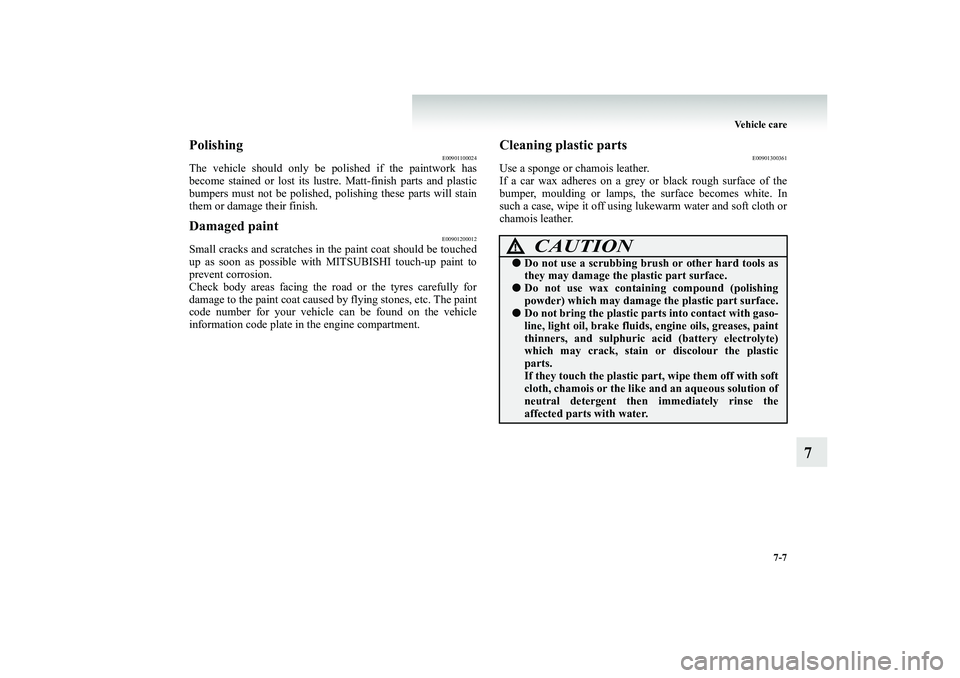
Vehicle care
7-7
7
Polishing
E00901100024
The vehicle should only be polished if the paintwork has become stained or lost its lustre. Matt-finish parts and plastic bumpers must not be polished, polishing these parts will stain them or damage their finish.Damaged paint
E00901200012
Small cracks and scratches in the paint coat should be touched up as soon as possible with
MITSUBISHI touch-up paint to
prevent corrosion.Check body areas facing the road or the tyres carefully for damage to the paint coat caused by
flying stones, etc. The paint
code number for your vehicle can be found on the vehicleinformation code plate in
the engine compartment.
Cleaning plastic parts
E00901300361
Use a sponge or chamois leather. If a car wax adheres on a grey
or black rough surface of the
bumper, moulding or lamps,
the surface becomes white. In
such a case, wipe it off using lukewarm water and soft cloth orchamois leather.
CAUTION
!●
Do not use a scrubbing brush or other hard tools as they may damage the plastic part surface.
●
Do not use wax containi
ng compound (polishing
powder) which may damage
the plastic part surface.
●
Do not bring the plastic part
s into contact with gaso-
line, light oil, brake fluids, engine oils, greases, paint thinners, and sulphuric ac
id (battery electrolyte)
which may crack, stain or
discolour the plastic
parts. If they touch the plastic pa
rt, wipe them off with soft
cloth, chamois or the like
and an aqueous solution of
neutral detergent then
immediately rinse the
affected parts with water.
BK-BK2008E1ENUK.en-uk-Section10.fm Page
7 Wednesday, January 9, 2008 4:48 PM
Page 449 of 538
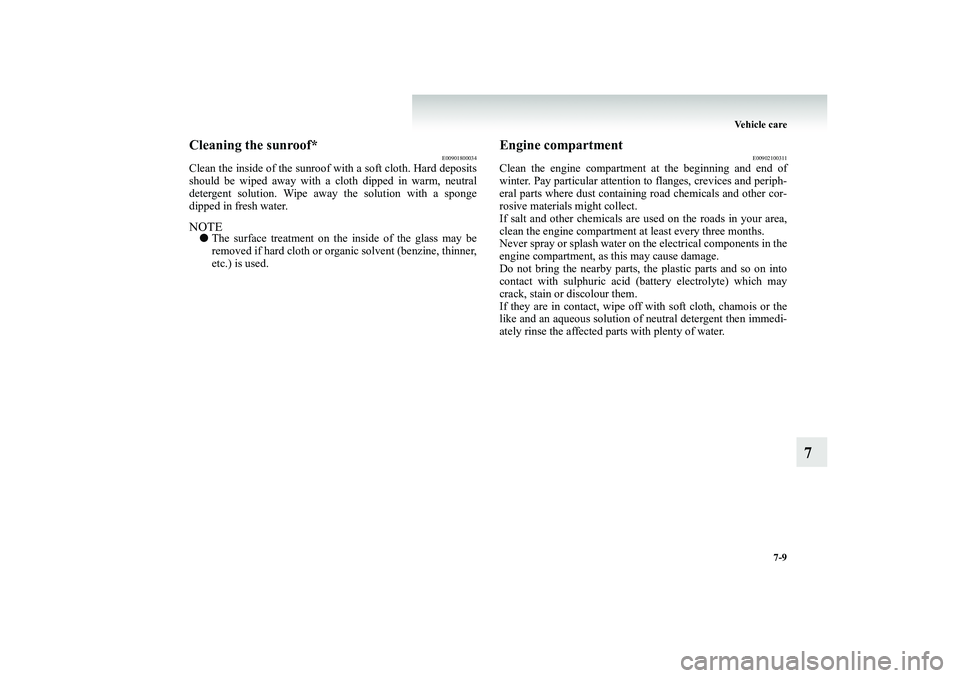
Vehicle care
7-9
7
Cleaning the sunroof*
E00901800034
Clean the inside of the sunroof wi
th a soft cloth. Hard deposits
should be wiped away with a cloth dipped in warm, neutral detergent solution. Wipe away the solution with a sponge dipped in fresh water.NOTE●
The surface treatment on the inside of the glass may be removed if hard cloth or organic solvent (benzine, thinner, etc.) is used.
Engine compartment
E00902100311
Clean the engine compartment
at the beginning and end of
winter. Pay particular attention
to flanges, crevices and periph-
eral parts where dust
containing road ch
emicals and other cor-
rosive materials might collect.If salt and other chemicals are
used on the roads in your area,
clean the engine compartment
at least every three months.
Never spray or splash water on the electrical components in theengine compartment, as
this may cause damage.
Do not bring the nearby parts, the plastic parts and so on into contact with sulphuric acid (battery electrolyte) which maycrack, stain or discolour them. If they are in contact, wipe off
with soft cloth, chamois or the
like and an aqueous solution of neutral detergent then immedi-ately rinse the affected pa
rts with plenty of water.
BK-BK2008E1ENUK.en-uk-Section10.fm Page
9 Wednesday, January 9, 2008 4:48 PM
Page 451 of 538
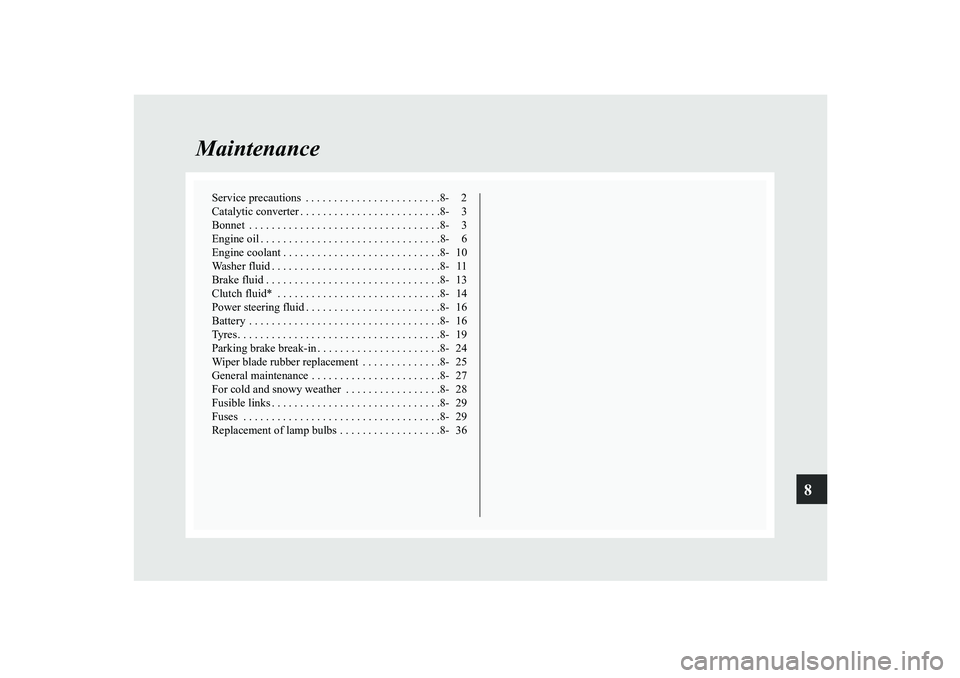
8
Maintenance
Service precautions . . . . . . . . . . . . . . . . . . . . . . . .8- 2 Catalytic converter . . . . . . . . . . . . . . . . . . . . . . . . .8- 3Bonnet . . . . . . . . . . . . . . . . . . . . . . . . . . . . . . . . . .8- 3Engine oil . . . . . . . . . . . . . . . . . . . . . . . . . . . . . . . .8- 6Engine coolant . . . . . . . . . . . . . . . . . . . . . . . . . . . .8- 10Washer fluid . . . . . . . . . . . . . . . . . . . . . . . . . . . . . .8- 11Brake fluid . . . . . . . . . . . . . . . . . . . . . . . . . . . . . . .8- 13Clutch fluid* . . . . . . . . . . . . . . . . . . . . . . . . . . . . .8- 14Power steering fluid . . . . . . . . . . . . . . . . . . . . . . . .8- 16Battery . . . . . . . . . . . . . . . . . . . . . . . . . . . . . . . . . .8- 16Tyres . . . . . . . . . . . . . . . . . . . . . . . . . . . . . . . . . . . .8- 19Parking brake break-in . . . . . . . . . . . . . . . . . . . . . .8- 24Wiper blade rubber replacement . . . . . . . . . . . . . .8- 25General maintenance . . . . . . . . . . . . . . . . . . . . . . .8- 27For cold and snowy weather . . . . . . . . . . . . . . . . .8- 28Fusible links . . . . . . . . . . . . . . . . . . . . . . . . . . . . . .8- 29Fuses . . . . . . . . . . . . . . . . . . . . . . . . . . . . . . . . . . .8- 29Replacement of lamp bulbs . . . . . . . . . . . . . . . . . .8- 36
BK-BK2008E1ENUK.en-uk-Section11.fm Page
1 Wednesday, January 9, 2008 4:50 PM
Page 452 of 538
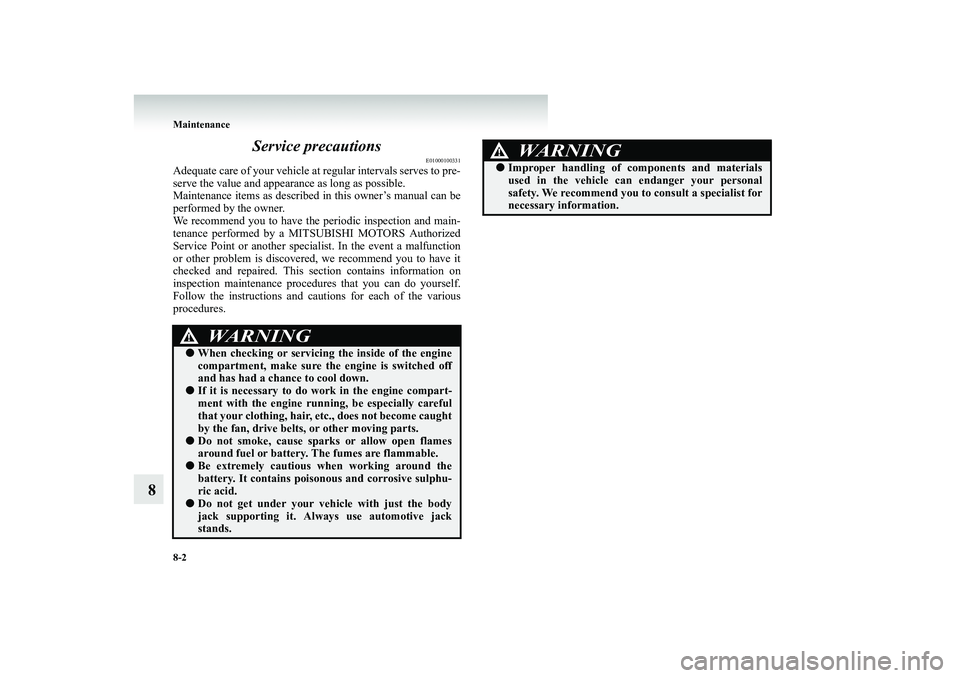
8-2 Maintenance
8
Service precautions
E01000100331
Adequate care of your vehicle at
regular intervals serves to pre-
serve the value and appear
ance as long as possible.
Maintenance items as described in this owner’s manual can beperformed by the owner. We recommend you to have the periodic inspection and main- tenance performed by a MITS
UBISHI MOTORS Authorized
Service Point or another specialist. In the event a malfunction or other problem is discovered, we recommend you to have it checked and repaired. This s
ection contains information on
inspection maintenance procedures that you can do yourself. Follow the instructions and
cautions for each of the various
procedures.
WARNING
!●
When checking or servicing
the inside of the engine
compartment, make sure th
e engine is switched off
and has had a chan
ce to cool down.
●
If it is necessary to do
work in the engine compart-
ment with the engine runni
ng, be especially careful
that your clothing, hair, et
c., does not become caught
by the fan, drive belts, or other moving parts.
●
Do not smoke, cause sparks or allow open flames around fuel or battery. The fumes are flammable.
●
Be extremely cautious wh
en working around the
battery. It contains poison
ous and corrosive sulphu-
ric acid.
●
Do not get under your vehicle with just the body jack supporting it. Always use automotive jackstands.
●
Improper handling of comp
onents and materials
used in the vehicle ca
n endanger your personal
safety. We recommend you to consult a specialist fornecessary information.WARNING
!
BK-BK2008E1ENUK.en-uk-Section11.fm Page
2 Wednesday, January 9, 2008 4:50 PM
Page 453 of 538
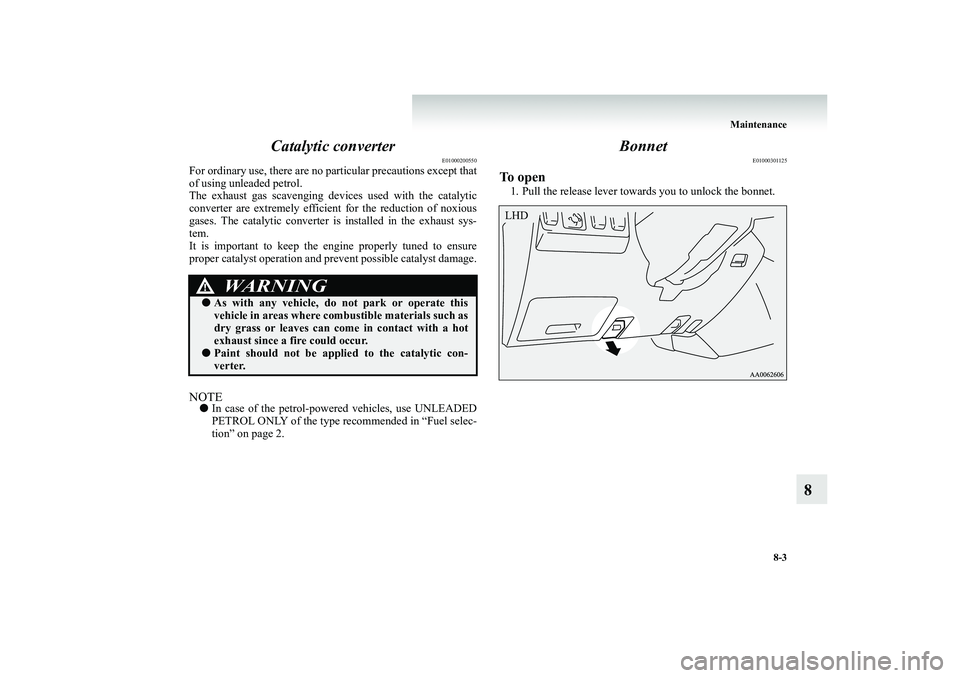
Maintenance
8-3
8
Catalytic converter
E01000200550
For ordinary use, there are no
particular precautions except that
of using unleaded petrol. The exhaust gas scavenging de
vices used with the catalytic
converter are extremely efficien
t for the reduction of noxious
gases. The catalytic converter is
installed in the exhaust sys-
tem.It is important to keep the engine properly tuned to ensure proper catalyst
operation and prevent po
ssible catalyst damage.
NOTE●
In case of the petrol-power
ed vehicles, use UNLEADED
PETROL ONLY of the type recommended in “Fuel selec- tion” on page 2.
Bonnet
E01000301125
To open 1. Pull the release lever towards you to unlock the bonnet.
WARNING
!●
As with any vehicle, do not park or operate this vehicle in areas where comb
ustible materials such as
dry grass or leaves can come in contact with a hotexhaust since a fire could occur.
●
Paint should not be applied to the catalytic con- verter.
LHD
BK-BK2008E1ENUK.en-uk-Section11.fm Page
3 Wednesday, January 9, 2008 4:50 PM
Page 456 of 538
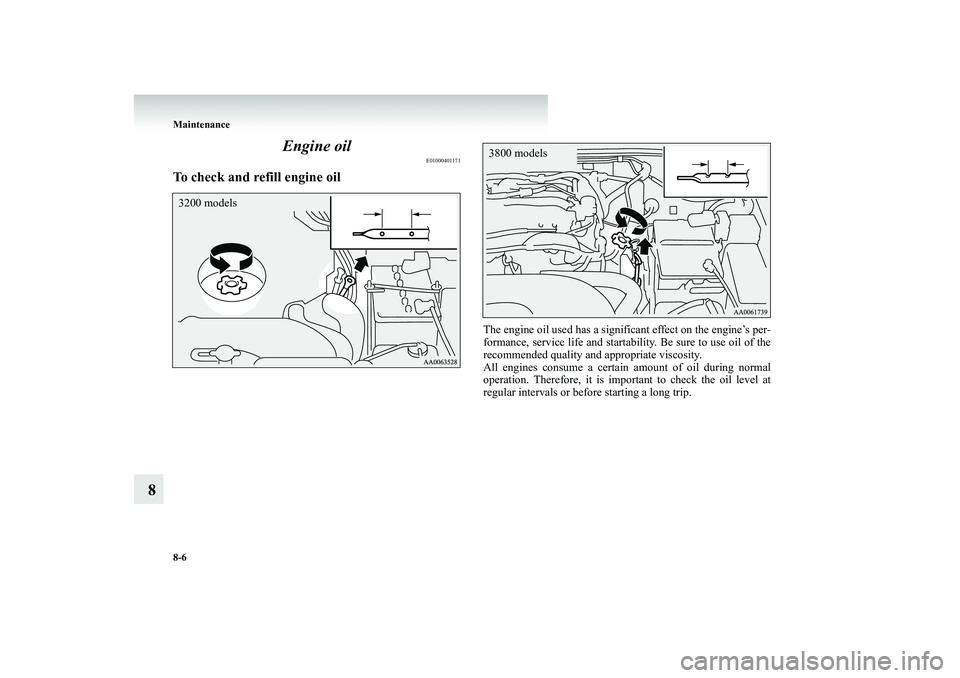
8-6 Maintenance
8
Engine oil
E01000401171
To check and refill engine oil
The engine oil used has a signifi
cant effect on the engine’s per-
formance, service life and startabi
lity. Be sure to use oil of the
recommended quality and appropriate viscosity. All engines consume a certain amount of oil during normal operation. Therefore, it is important to check the oil level atregular intervals or before starting a long trip.
3200 models
3800 models
BK-BK2008E1ENUK.en-uk-Section11.fm Page
6 Wednesday, January 9, 2008 4:50 PM
Page 457 of 538
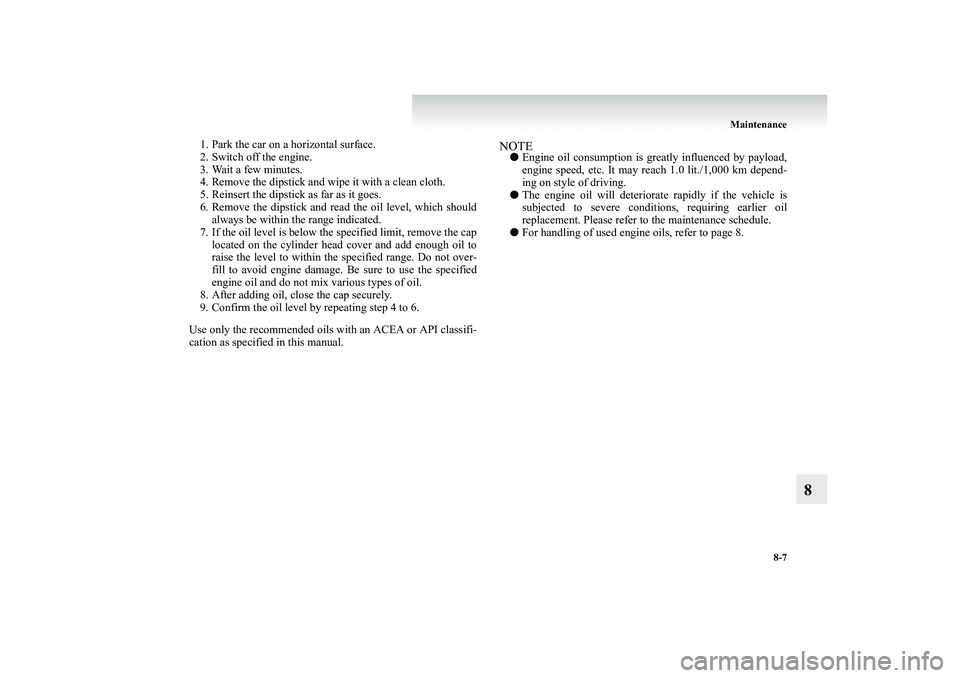
Maintenance
8-7
8
1. Park the car on a horizontal surface. 2. Switch off the engine. 3. Wait a few minutes. 4. Remove the dipstick and wi
pe it with a clean cloth.
5. Reinsert the dipstick as far as it goes. 6. Remove the dipstick and read the oil level, which should
always be within the range indicated.
7. If the oil level is below the specified limit, remove the cap
located on the cylinder head cover and add enough oil to raise the level to within the specified range. Do not over-fill to avoid engine damage. Be sure to use the specified engine oil and do not mix various types of oil.
8. After adding oil, cl
ose the cap securely.
9. Confirm the oil level by repeating step 4 to 6. Use only the recommended oils wi
th an ACEA or API classifi-
cation as specified in this manual.
NOTE●
Engine oil consumption is greatly influenced by payload, engine speed, etc. It may
reach 1.0 lit./1,000 km depend-
ing on style of driving.
●
The engine oil will deterior
ate rapidly if the vehicle is
subjected to severe conditions, requiring earlier oil replacement. Please refer to the maintenance schedule.
●
For handling of used engine oils, refer to page 8.
BK-BK2008E1ENUK.en-uk-Section11.fm Page
7 Wednesday, January 9, 2008 4:50 PM